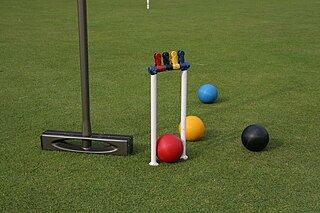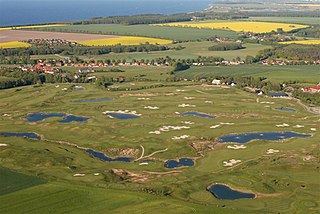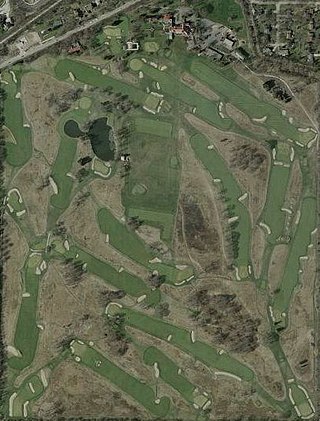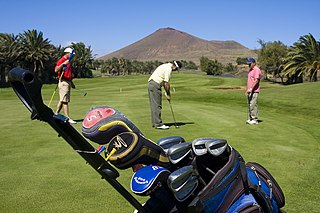
Croquet is a sport that involves hitting wooden, plastic, or composite balls with a mallet through hoops embedded in a grass playing court.

A sand wedge, or sand iron, is a type of golf club, an open-faced wedge primarily designed for getting out of sand bunkers. It has the widest sole of any wedge, which provides the greatest amount of bounce, allowing the club head to glide through sand and avoid digging in. After Gene Sarazen had success in 1932 with a new club that he had invented for sand play, its popularity quickly grew. The club can be advantageous in other soft lies—such as thick rough, soggy ground, or mud—and is also used from firmer grass lies for lobs or chips.

A golf course is the grounds on which the sport of golf is played. It consists of a series of holes, each consisting of a tee box, a fairway, the rough and other hazards, and a green with a cylindrical hole in the ground, known as a "cup". The cup holds a flagstick, known as a "pin". A standard round of golf consists of 18 holes, and as such most courses contain 18 distinct holes; however, there are many 9-hole courses and some that have holes with shared fairways or greens. There are also courses with a non-standard number of holes, such as 12 or 14.
A golf club is a club used to hit a golf ball in a game of golf. Each club is composed of a shaft with a grip and a club head. Woods are mainly used for long-distance fairway or tee shots; irons, the most versatile class, are used for a variety of shots; hybrids that combine design elements of woods and irons are becoming increasingly popular; putters are used mainly on the green to roll the ball into the hole. A set of clubs is limited by the rules of golf to a maximum of 14 golf clubs, and while there are traditional combinations sold at retail as matched sets, players are free to use any combination of legal clubs.

A golf ball is a ball designed to be used in golf. Under the rules of golf, a golf ball has a mass no more than 1.620 oz (45.9 g), has a diameter not less than 1.680 inches (42.7 mm), and performs within specified velocity, distance, and symmetry limits. Like golf clubs, golf balls are subject to testing and approval by The R&A and the United States Golf Association, and those that do not conform with regulations may not be used in competitions (Rule 5–1).
The following is a glossary of the terminology currently used in the sport of golf. Where words in a sentence are also defined elsewhere in this article, they appear in italics. Old names for clubs can be found at Obsolete golf clubs.
Titleist is an American brand of golf equipment produced by the Acushnet Company, headquartered in Fairhaven, Massachusetts, United States. Established in 1932 by Philip E. Young, it focuses on golf balls, clubs and golf bags.
The following is a partial timeline of the history of golf.

Long drive is a sport where players compete to hit or drive a golf ball the farthest. Top long drivers compete professionally in events and exhibitions.

Chicago Golf Club is a private golf club in the central United States, located in Wheaton, Illinois, a suburb west of Chicago. The oldest 18-hole course in North America, it was one of the five founding clubs of the United States Golf Association (USGA) in 1894. It was listed on the National Register of Historic Places in 2020.
The rules of golf consist of a standard set of regulations and procedures by which the sport of golf should be played. They are jointly written and administered by The R&A and the United States Golf Association (USGA). The R&A is the governing body of golf worldwide except in the United States and Mexico, which are the responsibility of the USGA. The rule book, entitled Rules of Golf, is updated and published on a regular basis and also includes rules governing amateur status.

Flying disc sports are sports or games played with discs, often called by the trademarked name Frisbees. Ultimate and disc golf are sports with substantial international followings.
The Stimpmeter is a device used to measure the speed of a golf course putting green by applying a known velocity to a golf ball and measuring the distance traveled in feet.

Golf equipment encompasses the various items that are used to play the sport of golf. Types of equipment include the golf ball, golf clubs, and devices that aid in the sport.
In the sport of golf, a penalty or penalty stroke is an additional stroke or strokes added to a player's score for an infraction of the rules. In match play, rather than adding strokes, the usual penalty is loss of the hole except for penalties assessed for relief from a hazard or a lost ball.

A wood is a type of club used in the sport of golf. Woods have longer shafts and larger, rounder heads than other club types, and are used to hit the ball longer distances than other types.

Golf is a club-and-ball sport in which players use various clubs to hit a ball into a series of holes on a course in as few strokes as possible.

The golf swing is the action by which players hit the ball in the sport of golf. The golf swing is a complex motion involving the whole body; the technicalities of the swing are known as golf stroke mechanics.
The Alternative Golf Association, also known as Flogton, was formed in 2011 by a group of Silicon Valley executives. It tried to encourage golf participation by relaxing or ignoring traditional rules to reduce player frustration. According to the National Golf Foundation, there was a decline in the number of golfers and rounds played in 2011 compared to 2005. Flogton aspired to stimulate golf as snowboarding helped skiing. Patrick J. Gallagher (CEO), Scott McNealy (Commissioner) and Bob Lurie were involved with Flogton.

Herbert Hartley Ramsay was an American attorney and golf administrator. He was president of the United States Golf Association and was responsible for enacting policies that were key in shaping competitive golfing as it is known today. He was also the sports broadcaster for the first Masters Tournament.












